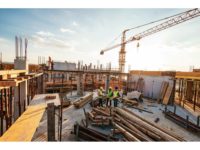A Q&A on AI's Role in Building Code Compliance

10 Prospect (Photography by Connie Zhou)
Navigating building codes and compliance is an often challenging process due to the ever-evolving nature of regulations. Because of that, making sure designs meet all relevant standards can be time-consuming and prone to human error.
Michael Schroeder, partner at SGA, spearheads new tech initiatives at the firm so that designers can spend less time on the minutiae. When exploring what exists in the realm of AI and its capabilities, one significant advantage Michael found is that AI can improve the efficiency of building code compliance by streamlining the interpretation and application of regulations, ultimately speeding up the process and reducing the likelihood of errors.
Recently, Michael joined us for a Q&A interview to chat more about AI’s role in building compliance and how his team is implementing it into their practices.
1. Can you explain how AI is currently being used in building code compliance and what advantages it offers over traditional methods?
We find uses in the summarization of complex code sections and also find it useful to read the AI’s interpretation of a section compared to the actual code text. Building codes are legal documents and are not easy to read for those unfamiliar with legal terminology. We often find ourselves rereading the same code section several times to understand how it applies to a given design. This is relatively inefficient, and if we can gain a more thorough understanding with alternative descriptions. This can speed up the process.
2. What specific AI tools or technologies is SGA implementing to streamline the interpretation and application of building regulations?
Today, there are mainly two approaches. One is using commercial LLMs such as ChatGPT, Gemini, or Claude. This process requires simply uploading the code sections for context. Large context windows can now process hundreds of pages of documents simultaneously. Establish a prompt to direct the LLM to retrieve and organize the response in the way you need. For example, a prompt may read: respond as an expert in code compliance, think step by step, and cite code sections in response.
Alternatively, existing software for code research, such as UpCodes, includes AI features. We’ve chosen not to implement that feature after initial testing. I’m sure it will improve as the foundational models it relies on grow in capability.
3. How does AI improve the efficiency of compliance checking? Can you provide examples of how it has sped up the process and reduced errors in your projects?
One example of the NYC Zoning resolution for obstruction reads: ..such obstructions shall be located not less than 10 feet from the street wall of a building, except that such obstructions need not be set back more than 25 feet from a narrow street line or more than 20 feet from a wide street line. However, such restrictions on location shall not apply to elevator or stair bulkheads (including shafts or vestibules), provided the aggregate width of street walls of such bulkheads within 10 feet of a street wall, facing each street frontage, does not exceed 30 percent of the street wall width of the building facing such frontage;
Asking an AI to create a formula for this section results in the following:

4. What are some common challenges or limitations you’ve encountered with AI tools in the context of building code compliance, and how do you address them?
Our industry relies heavily on code consultants who interpret our design requirements and translate them into actionable feedback that we can incorporate into our designs. AI may close this gap someday, but the error rate is high enough that we can only rely on it with human oversight. Even human experts are wrong some percentage of the time. However, we cannot rely on AI until it is at least ten times better than a human consultant.
5. In what ways does AI assist designers in making more informed decisions early in the design process?
Early in the design process, we are faced with many open questions. This grey area creates design opportunities for our designers to leverage AI’s ability to fill in the gaps with contextual information. For rendering and visualization, AI’s ability to hallucinate often provides paths for exploration. For example, it’s the opposite of wanting a precise output for building code interpretation.
6. How does SGA ensure the accuracy and reliability of AI-generated compliance checks?
We rely on our professionals to oversee every aspect of the project. Just as if we had an inexperienced intern working on a project, work is overseen by experienced Architects who check the work and assist in training.
8. How do you balance the use of AI tools with the need for human oversight and critical thinking, especially in complex or unique projects?
Today, AI workflows are highly iterative, with both AI and humans in the loop. Humans still provide the overarching project context and oversight.
9. What future advancements in AI technology do you foresee that could further enhance building code compliance processes?
The current crop of large language modes cannot reason deeply. Until this capability is unlocked, AI will be relegated to small one-off tasks. Reasoning abilities will change the nature of AI. These capabilities will allow it to create chains of reasoning and sub-goals. Then, the AI will be seen as a teammate rather than a simple tool.
Looking for a reprint of this article?
From high-res PDFs to custom plaques, order your copy today!






